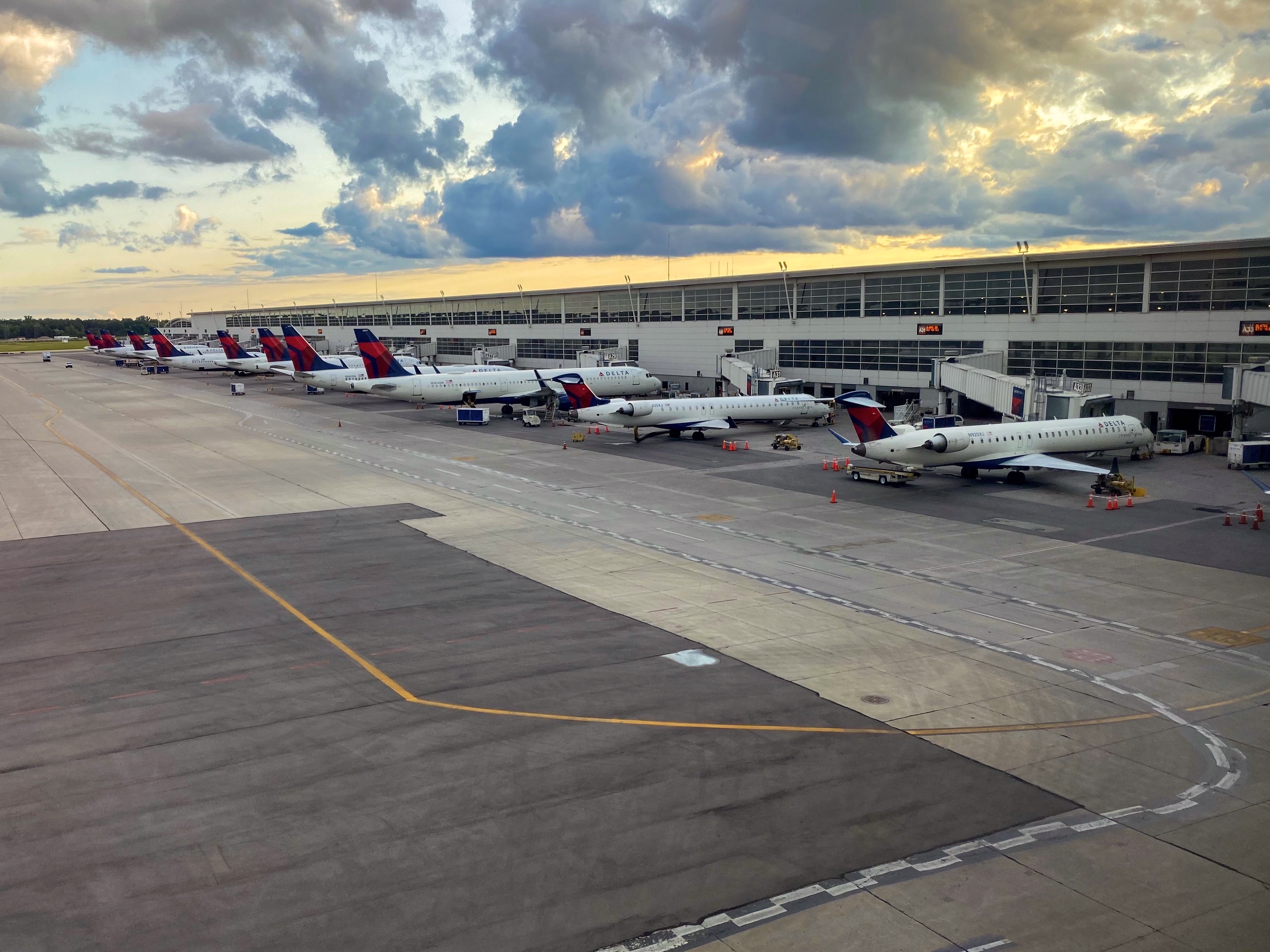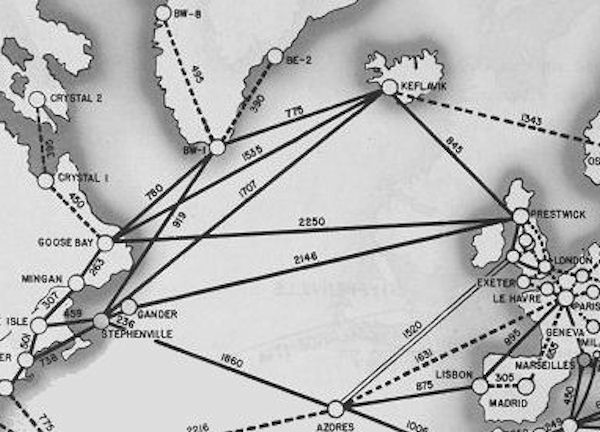|
Kuujjuaq Airport
Kuujjuaq Airport is located southwest of Kuujjuaq, Quebec, Canada. History The airport site at Fort Chimo was located and surveyed on 12 July 1941 by a United States Army Air Forces (USAAF) team under Captain Elliott Roosevelt, operating by amphibious aircraft out of Gander, Newfoundland and Labrador. The chosen site was upstream from the trading post, on the opposite shore. River access was difficult due to shifting, sandy banks and ice and high tides in the estuary. Code-named Crystal I, Fort Chimo was founded on 10 October 1941 by a 12-man weather station and radio communications crew under Antarctic veteran and former Lieutenant Commander, Isaac Schlossbach. Runway construction commenced next summer. The Crystal stations were part of the Crimson East project for trans-Atlantic ferry flights, Chimo being referred to as "Bookie". Fort Chimo did not actually serve in this intended capacity, but the station was useful for weather reporting, communications, and local support ... [...More Info...] [...Related Items...] OR: [Wikipedia] [Google] [Baidu] |
Kativik Regional Government
The Kativik Regional Government (french: Administration régionale Kativik, KGR) encompasses most of the Nunavik region of Quebec. Nunavik is the northern half of the Nord-du-Québec administrative region and includes all the territory north of the 55th parallel. The administrative capital is Kuujjuaq, on the Koksoak River, about 50 kilometres inland from the southern end of the Ungava Bay. In accordance with the 1975 James Bay and Northern Quebec Agreement, the KRG was established by the 1978 ''Act respecting Northern Villages and the Kativik Regional Government''Kativik Act. Representation The Kativik Regional Government includes 14 northern villages, 14 Inuit reserved lands and one Naskapi village municipality. Each Inuit reserved land is near a northern village; the Naskapi village municipality of Kawawachikamach (north of the 55th parallel) is near the Naskapi reserved land that is also called Kawawachikamach, south of the 55th parallel in the Côte-Nord region of Quebe ... [...More Info...] [...Related Items...] OR: [Wikipedia] [Google] [Baidu] |
Arctic
The Arctic ( or ) is a polar regions of Earth, polar region located at the northernmost part of Earth. The Arctic consists of the Arctic Ocean, adjacent seas, and parts of Canada (Yukon, Northwest Territories, Nunavut), Danish Realm (Greenland), Finland, Iceland, Norway, Russia (Murmansk Oblast, Murmansk, Siberia, Nenets Autonomous Okrug, Nenets Okrug, Novaya Zemlya), Sweden and the United States (Alaska). Land within the Arctic region has seasonally varying snow and sea ice, ice cover, with predominantly treeless permafrost (permanently frozen underground ice) containing tundra. Arctic seas contain seasonal sea ice in many places. The Arctic region is a unique area among Earth's ecosystems. The cultures in the region and the Arctic indigenous peoples have adapted to its cold and extreme conditions. Life in the Arctic includes zooplankton and phytoplankton, fish and marine mammals, birds, land animals, plants and human societies. Arctic land is bordered by the subarctic. De ... [...More Info...] [...Related Items...] OR: [Wikipedia] [Google] [Baidu] |
Mandatory Frequency Airport
An airport with a mandatory frequency (MF), mandatory traffic advisory frequency (MTAF) or air/ground radio (A/G) is an airport which does not have a control tower but still requires arriving and departing aircraft to communicate with other aircraft or a radio operator on a published frequency. Mandatory frequency airports are rare in the United States, one example being Ketchikan International Airport (), but they are common in other countries such as Canada, Australia, the United Kingdom and Norway; often, an MF or MTAF airport is one with scheduled passenger service but insufficient traffic to support a control tower. If there is a flight service specialist monitoring the frequency, the specialist will give pilots advisories about traffic, weather, and surface conditions, and may relay IFR clearances from en route controllers, but cannot give clearances themselves. In the United Kingdom, this type of airport is said to have an Air/Ground Radio service, using the callsign suff ... [...More Info...] [...Related Items...] OR: [Wikipedia] [Google] [Baidu] |
Leadership In Energy And Environmental Design
Leadership in Energy and Environmental Design (LEED) is a green building certification program used worldwide. Developed by the non-profit U.S. Green Building Council (USGBC), it includes a set of rating systems for the design, construction, operation, and maintenance of green buildings, homes, and neighborhoods, which aims to help building owners and operators be environmentally responsible and use resources efficiently. By 2015, there were over 80,000 LEED-certified buildings and over 100,000 LEED-accredited professionals. Most LEED-certified buildings are located in major U.S. metropolises. LEED Canada has developed a separate rating system adapted to the Canadian climate and regulations. Some U.S. federal agencies, state and local governments require or reward LEED certification. This can include tax credits, zoning allowances, reduced fees, and expedited permitting. Studies have found that for-rent LEED office spaces generally have higher rents and occupancy rates and ... [...More Info...] [...Related Items...] OR: [Wikipedia] [Google] [Baidu] |
Nav Canada
Nav Canada (styled as NAV CANADA) is a privately run, not-for-profit corporation that owns and operates Canada's civil air navigation system (ANS). It was established in accordance with the ''Civil Air Navigation Services Commercialization Act'' (ANS Act). The company employs approximately 1,900 air traffic controllers (ATCs), 650 flight service specialists (FSSs) and 700 technologists. It has been responsible for the safe, orderly and expeditious flow of air traffic in Canadian airspace since November 1, 1996 when the government transferred the ANS from Transport Canada to Nav Canada. As part of the transfer, or privatization, Nav Canada paid the government CA$1.5 billion. Nav Canada manages 12 million aircraft movements a year for 40,000 customers in over 18 million square kilometres, making it the world's second-largest air navigation service provider (ANSP) by traffic volume. Nav Canada, which operates independently of any government funding, is headquartered in Ottawa, O ... [...More Info...] [...Related Items...] OR: [Wikipedia] [Google] [Baidu] |
North Atlantic Air Ferry Route In World War II
The North Atlantic air ferry route was a series of Air Routes over the North Atlantic Ocean on which aircraft were ferried from the United States and Canada to Great Britain during World War II to support combat operations in the European Theater of Operations (ETO). The route was developed as one of four major routes along which United States aircraft were ferried to the major combat areas. It originated at several Army Air Bases in New England, which permitted short range single-engined aircraft to be flown to Britain using a series of intermediate airfields in Newfoundland, Labrador, Greenland and Iceland. Long-range multi-engined aircraft could be flown from Newfoundland directly using Great Circle routes to airfields in Ireland and southwest England; or via the Azores to the UK or airfields in French Morocco to support Allied air forces in the Mediterranean Theater of Operations (MTO). Later in the war, air routes over the North Atlantic were developed from South Florida ... [...More Info...] [...Related Items...] OR: [Wikipedia] [Google] [Baidu] |
Baffin Island
Baffin Island (formerly Baffin Land), in the Canadian territory of Nunavut, is the largest island in Canada and the fifth-largest island in the world. Its area is , slightly larger than Spain; its population was 13,039 as of the 2021 Canadian census; and it is located at . It also contains the city of Iqaluit, the capital of Nunavut. Name The Inuktitut name for the island is , which means "very big island" ( "island" + "very big") and in Inuktitut syllabics is written as . This name is used for the administrative region the island is part of ( Qikiqtaaluk Region), as well as in multiple places in Nunavut and the Northwest Territories, such as some smaller islands: Qikiqtaaluk in Baffin Bay and Qikiqtaaluk in Foxe Basin. Norse explorers referred to it as ("stone land"). In 1576, English seaman Martin Frobisher made landfall on the island, naming it "Queen Elizabeth's Foreland" and Frobisher Bay is named after him. The island is named after English explorer William Baff ... [...More Info...] [...Related Items...] OR: [Wikipedia] [Google] [Baidu] |
Detroit Metropolitan Airport
Detroit Metropolitan Wayne County Airport , usually called Detroit Metro Airport, Metro Airport, or simply DTW, is a major international airport in the United States covering effective December 30, 2021. in Romulus, Michigan. It is the primary international airport serving Detroit and is Michigan's busiest airport. The Federal Aviation Administration (FAA) National Plan of Integrated Airport Systems for 2017–2021 categorized it as a large hub primary commercial service facility. The airport is a major hub for Delta Air Lines and is also a base for Spirit Airlines. Detroit serves as Delta's main gateway to Asia for the Eastern United States. The airport has service to 30 international destinations and service to 39 states across the United States. Operated by the Wayne County Airport Authority, the airport has six runways, two terminals, and 129 in-service gates. Detroit Metropolitan Airport has maintenance facilities capable of servicing and repairing aircraft as large as ... [...More Info...] [...Related Items...] OR: [Wikipedia] [Google] [Baidu] |
Presque Isle International Airport
Presque Isle International Airport , formally Northern Maine Regional Airport at Presque Isle, is a mile northwest of Presque Isle, in Aroostook County, Maine, United States. It serves the residents of Presque Isle and a vast area of northern Maine and northwestern New Brunswick. Airline flights to Newark Liberty International Airport are subsidized by the federal government's Essential Air Service program at a cost of $3,892,174 (per year). Federal Aviation Administration records say the airport had 13,385 passenger boardings (enplanements) in calendar year 2008, 13,513 in 2009 and 15,052 in 2010. The National Plan of Integrated Airport Systems for 2011–2015 categorized it as a ''primary commercial service'' airport (more than 10,000 enplanements per year). The airport has the third longest active runway in Maine at 7439' (behind Bangor International Airport, 11,440' and Brunswick Executive Airport, formerly Naval Air Station Brunswick runway 1R/19L, 8000'), and fifth lon ... [...More Info...] [...Related Items...] OR: [Wikipedia] [Google] [Baidu] |
Presque Isle Air Force Base
Presque Isle Air Force Base was a military installation of the United States Air Force located near Presque Isle, Maine. In the late 1950s and early 1960s it became a base for Strategic Air Command. The original airport was constructed in 1930 by the Civilian Conservation Corps as a commercial airport located west of the "business center". In 1941, the federal government appropriated the local airport, establishing Presque Isle Army Airfield for planes bound to and from Great Britain. It was activated as an Army Air Corps field on 15 September 1941. The main Army Air Force unit at Presque Isle was the 23d AAF Ferrying Wing, assigned to the Air Transport Command. It was closed after the war ended The airfield was reactivated by the United States Air Force and redesignated Presque Isle Air Force Base on January 12, 1948, assigned to the Air Defense Command (ADC) Eastern Air Defense Force. The 23rd Fighter Group was redesignated as the 23rd Fighter-Interceptor Group, and activ ... [...More Info...] [...Related Items...] OR: [Wikipedia] [Google] [Baidu] |
Air Transport Command
Air Transport Command (ATC) was a United States Air Force unit that was created during World War II as the strategic airlift component of the United States Army Air Forces. It had two main missions, the first being the delivery of supplies and equipment between the United States and the overseas combat theaters; the second was the ferrying of aircraft from the manufacturing plants in the United States to where they were needed for training or for operational use in combat. ATC also operated a worldwide air transportation system for military personnel. Inactivated on 1 June 1948, Air Transport Command was the precursor to what became the Military Air Transport Service in 1948 and was redesignated Military Airlift Command (MAC) in 1966. It was consolidated with MAC in 1982, providing a continuous history of long range airlift through 1992 when the mission was transferred to today's Air Mobility Command. History By no means least among the achievements of the Army Air Forces ... [...More Info...] [...Related Items...] OR: [Wikipedia] [Google] [Baidu] |
Padloping Island
Paallavvik (Inuktitut syllabics: ''ᐹᓪᓚᕝᕕᒃ'', ''Paallavvik'' means 'the place where one stumbles', from ''paallat'' 'to stumble' + -''vik'' 'place for X-ing', or ''paallakpuq'' 'to fall down (forward), trip, fall forward') formerly Padloping Island is an uninhabited island in the Qikiqtaaluk Region of Nunavut, Canada. It is located in Merchants Bay, just to the south of Davis Strait, and off the eastern coast of Baffin Island. The smaller Aggijjat (formerly Durban Island) is approximately to the east, while Auyuittuq National Park is to the west. Geography It measures long, by wide. History Padloping was originally an Inuit community on the island by the same name. In July 1941, a United States Army Air Forces (USAAF) team headed by Captain Elliott Roosevelt conducted aerial reconnaissance for an airport site in the region of Baffin Island closest to Greenland. Roosevelt selected the southern edge of Paallavvik as the most promising, there being no better places ... [...More Info...] [...Related Items...] OR: [Wikipedia] [Google] [Baidu] |

.jpg)






